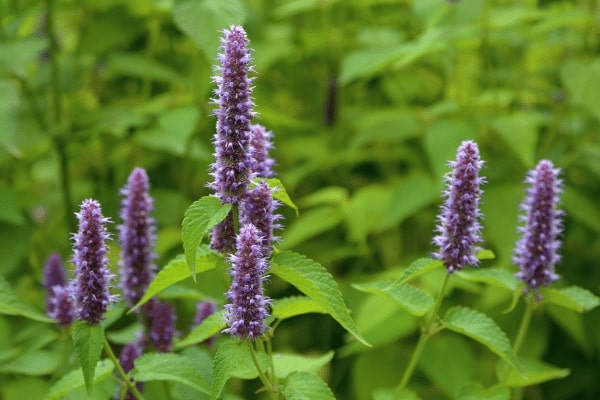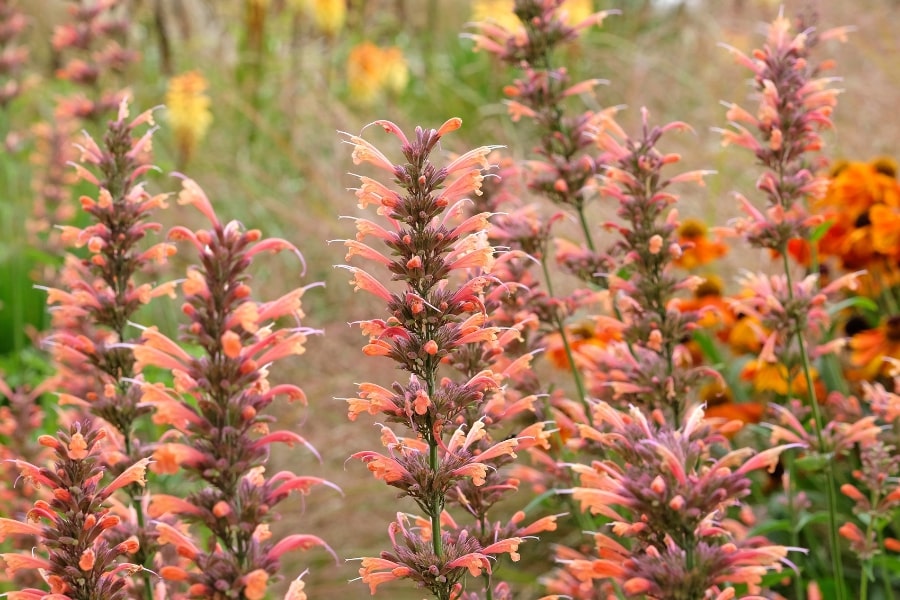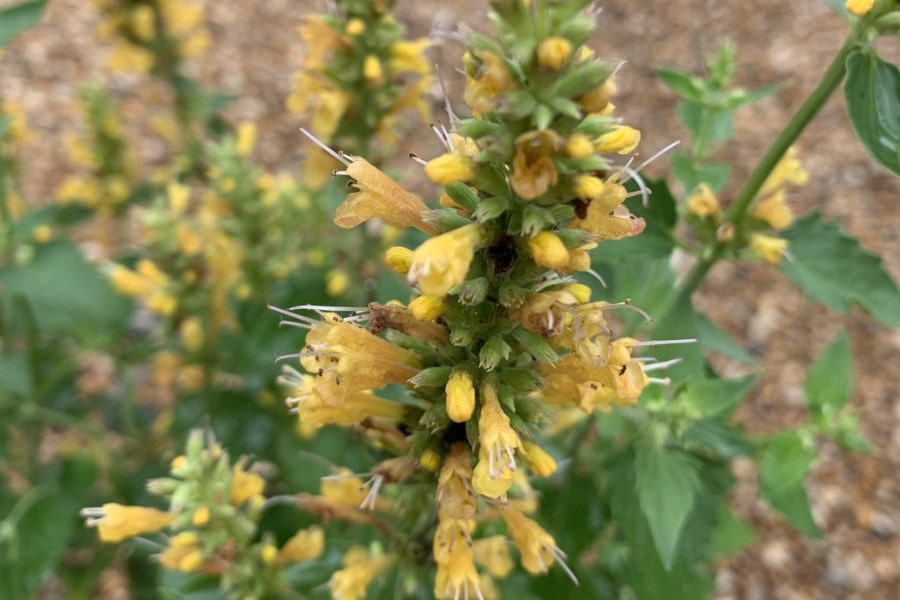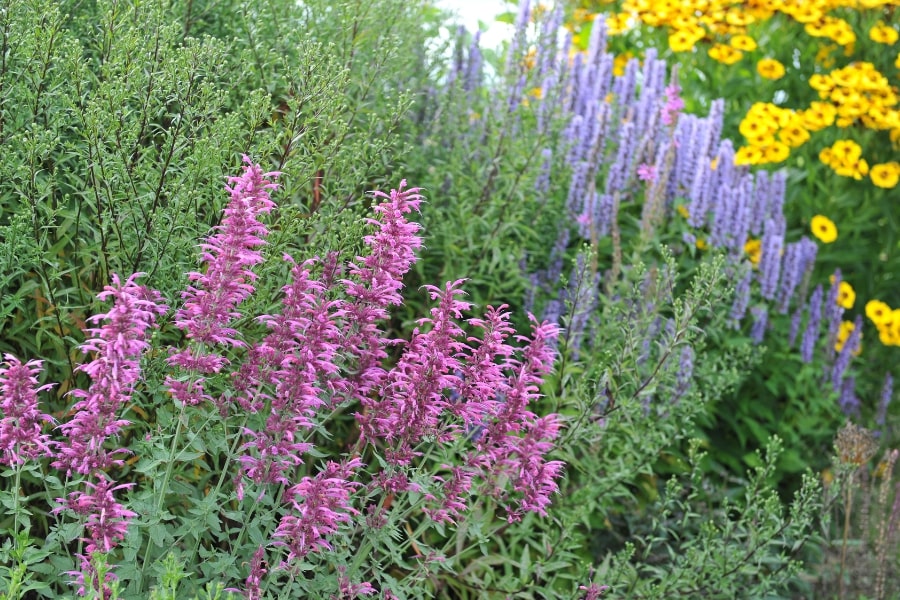The best Hummingbird attractor we see at Martin Garden Center is Agastache. Commonly known as Hyssop, and recently being called Hummingbird Mint, this plant commands attention with its tall, upright flower spikes and endless array of brilliant colors. Ranging from soft pastels to vivid shades of orange, pink, purple, and blue, its blooms rise 2 to 5 feet above aromatic foliage, creating a vertical accent that dances in the breeze. These long-lasting flowers are irresistible to hummingbirds, which dart from spike to spike throughout the day, adding motion and life to the garden. If the nickname “Hummingbird Mint” didn’t give it away, Agastache is known for attracting hummingbirds into the garden.

Our Selection of Agastache
At Martin Garden Center, we grow several varieties of Agastache in 4″ containers. REMINDER: We will carry these varieties this year, but we cannot guarantee that we will have them at all times. We are growing these varieties in 2025:
- Beelicious Pink
- Black Adder
- Blue Boa
- Blue Fortune
- Coronado Red
- Kudos Red
- Little Adder
- Morello
- Poquito Butter Yellow
Growing and Caring For Agastache
Sunlight is a key ingredient for Agastache’s success. These plants are sun-lovers, thriving in full sun to light shade. Agastache can tolerate more sun in areas with cooler summers, while in regions with intense heat, providing some afternoon shade can prevent stress and sunburn. The sun’s warmth encourages vigorous growth and enhances the release of its intoxicating fragrance.
Agastache thrives in well-drained soil with a slightly alkaline to neutral pH. While the plants appreciate regular watering during their establishment period, they are drought-tolerant once they mature. Soil that retains too much moisture can lead to root rot, so ensuring proper drainage is crucial to the plant’s health. Allow the soil to dry out between waterings to strike the right balance. Applying a layer of mulch around the base of the plants can help conserve soil moisture and regulate temperature fluctuations.
These plants are relatively disease and pest-resistant, but it’s still a good practice to monitor for any signs of pests and address them if necessary. Because this plant is a pollinator attractor, avoid any systemic chemicals and avoid spraying when bees are present.

Leaves and Flowers
Agastache leaves are lance-shaped or ovate and often tinged with shades of gray or green. These leaves are coated with fine hairs that contribute to their slightly fuzzy appearance, which reduces water loss through transpiration, making them well-suited to drier conditions. Upon touching the leaves, a delightful scent is released, adding another sensory dimension to their appeal.
The flowers of Agastache are arranged in vertical spikes that rise above the foliage. They showcase a striking spectrum of colors, ranging from shades of pink, purple, and lavender to warm hues of orange and red. The unique tubular shape of the flowers, often referred to as “bottlebrush” spikes, provides a convenient landing platform for pollinators seeking nectar. These blooms are magnets for hummingbirds, bees, butterflies, and other beneficial insects.

Uses in the Garden
Agastache Blue Boa is one of the best pollinator attractors that we have ever seen at Martin Garden Center. If you are attempting to attract pollinators to your garden, consider this perennial as a must. Another very popular Agastache is the Kudos series, which has more tubular flowers ranging in colors across the spectrum. Recently, Agastache is being called Hummingbird Mint, which really confuses the heck out of people. But, hummingbirds are extremely attracted to it, particularly the Kudos Red variety.
Beyond its ability to attract pollinators, Agastache is a versatile and low-maintenance plant that fits beautifully into a variety of garden designs. Its upright growth habit and long-lasting blooms make it an excellent choice for mixed perennial borders, where it adds height, texture, and a pop of color from midsummer to fall. Agastache also thrives in rock gardens and xeriscapes, as it is highly drought-tolerant once established. For a stunning contrast, plant it alongside ornamental grasses, coneflowers, or black-eyed Susans to create a dynamic, pollinator-friendly display. It also works well in container gardens, where its fragrant foliage and bright flowers provide visual interest on patios and balconies.

Frequently Asked Questions
Is Agastache A Perennial?
Yes, Agastache is a genus of herbaceous perennial plants. Agastache species are generally hardy and can be grown as perennials in a variety of climates, including the South Carolina Upstate.
Is Agastache Deer Resistant?
The aromatic allure of Agastache often causes deer to steer clear of its vicinity. Agastache foliage, which can have scents reminiscent of anise or licorice, is thought to be a deterrent for deer. Yet, in the nuanced dance of nature, no guarantee exists.
Is Agastache Invasive?
In general, most Agastache species are well-behaved and clump-forming. They spread gradually through rhizomes or self-seeding, but they typically do not exhibit the aggressive spreading behavior associated with invasive plants. Some self-seeding can be desirable for naturalizing in a garden, but it’s usually manageable.
